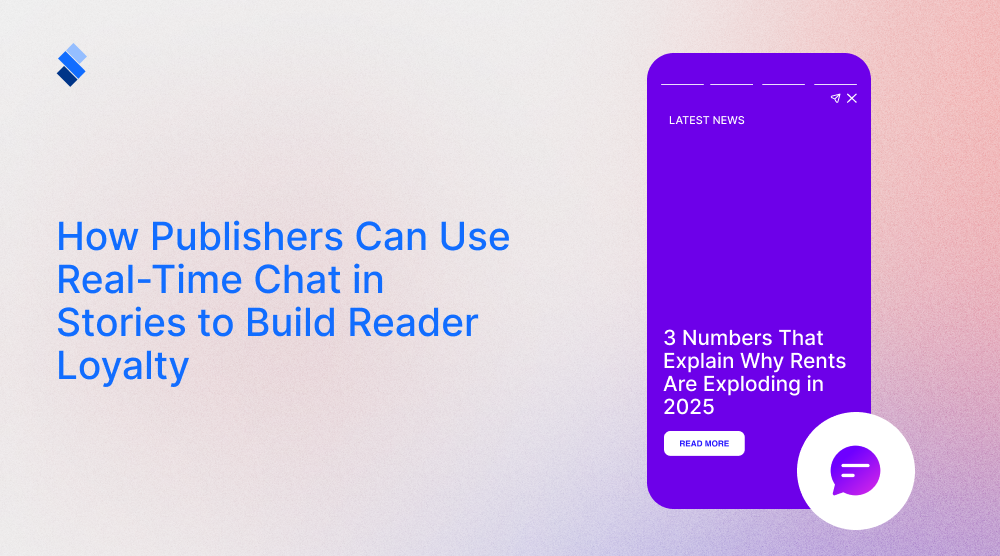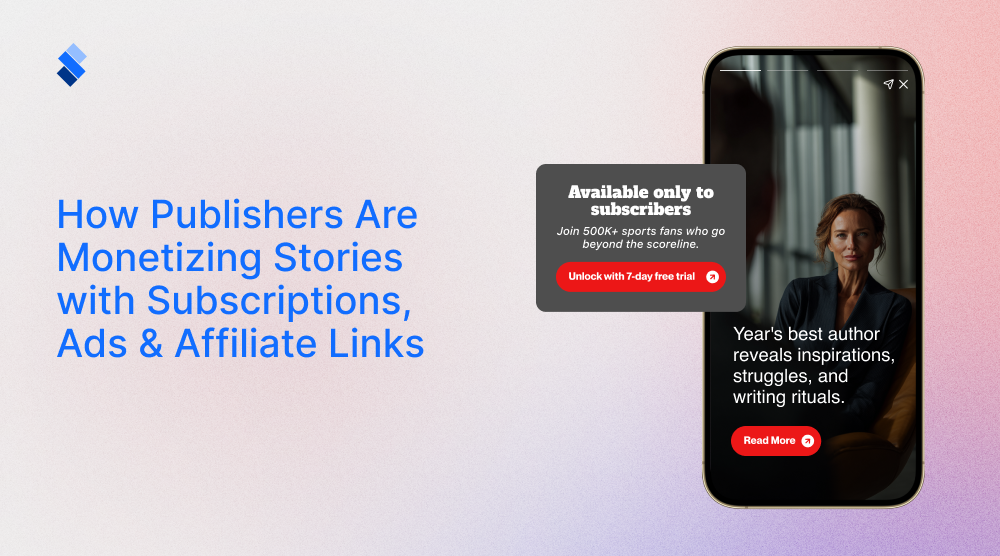Web stories for publishers
The importance of web stories for publishers is hard to overstate, especially if you take into account modern marketing trends.

As an online publisher, you are always on the hunt for new types of content. On the one hand, you want to find something that is interesting, entertaining, and engaging. On the other, you ought to keep pricing in mind, as different content requires different recourses to create. Well, we will use this article to outline why web stories cover both of these aspects with flying colors. And why web stories for publishers are soon becoming a necessity.
Web stories for publishers - what you need to know
We will use the first couple of paragraphs to go elaborate a bit on what web stories are. Seeing that we've already written numerous articles about web stories, we won't go into much depth here. If you are completely new to the concept of web stories, we do suggest that you continue reading this article as it is written. If you wish to solely learn about the benefits that web stories bring to publishers, feel free to skip to the chapter below.
What are web stories?
Web stories are a fairly novel type of online content. In their essence, web stories are visually based content that encompasses various elements. The easiest way to find examples of web stories is to check out Google's web stories, or simply head to either Facebook or Instagram. All three of these platforms have recognized early how effective web stories can be in online marketing. And that by using them you can have your viewers glued to their screens as they absorb whatever info you deem necessary.

What content can you use in web stories?
In theory, there is no limit to what you can use as story content. Videos, images, animations, polls, add, links and CTAs, bookends... All these are viable elements that you can look to incorporate into your web stories. The most common format of web stories is a combination of images and some written content. But you, as a publisher, should feel no pressure to limit yourself to what is most common. Know that modern tools like StorifyMe give you a ton of options when it comes to design and creativity. So, you should feel free to experiment.
Where can you host web stories?
Another great thing about web stories is that you can host them wherever you please. StorifyMe allows you to export web stories as widgets. As such, you can incorporate them into your website, your social media, your apps, and your newsletter. You can even look to create QR codes that directly point to your web stories, as a way to combine offline and online marketing. All in all, there are tons of ways in which you can make use of web stories. The only limit is how creative you are.
The value of web stories for publishers
If you are an experienced publisher, you likely already have an idea or two on how to use web stories. Depending on what kind of content you deal with, web stories can serve different purposes. So, let's go through them to give you a more complete idea.
SEO value
A big part of what makes gives value to web stories for publishers is SEO. Namely, when compared to other types of content, web stories stand strong as an effective way to boost your SEO value. This is mostly because people are far more ready to view an entire web story than to watch a full video or read an article. The second reason is that Google values web stories quite much. Compared to blog posts or videos, web stories will give you far more bang for your buck in SEO ranking. And, it shouldn't go without notice that a lot of publishers are still unaware of web stories. Therefore, the competition in web story SEO is still low when compared to blog posts and videos.

Marketing potential
Depending on what brand you wish to market, web stories can have tremendous marketing potential. Brands that rely on visual content can have tremendous results by relying on web stories. And even if brands don't rely on visual content, they can likely still find some use for web stories. The only obstacle is understanding the web story format and how the brand in question can integrate itself with it.
Showcasing interesting articles
If you are having trouble finding ways to showcase articles, web stories can be a great tool to rely on. Namely, what you can do is use the web store as a makeshift "trailer" for the article. A quick, interesting quote from the article, placed in front of a related image can be all you need to gain the interest of a potential reader. While this cannot ensure that the reader will go through the entire article, it will ensure that they will at least visit it. You'd be surprised at how much traffic you can get through planned, well-crafted use of web stories.
Again, it is important to understand how your brand visually relates to web stories. Ideally, people will be able to recognize that a web story is yours before they even go through it. This is primarily done through visual elements like picking and sticking with a suitable color palette, and by placing the elements within the story in a similar way.
Elevating previous content to new levels
A good rule of thumb for new publishers is to let your old content get stale. If you have articles that were once popular, but over time dropped in traffic you really ought to do something to freshen them up a bit. The common way in which people do this is by integrating new links and therefore naturally contenting well-performing articles to newer ones. Another way to freshen up your blog posts is by integrating web stories.

Web stories can contain links to other articles, which is a tried and true way to refresh. Besides this, you can also use web stories to boost your written content. Visual explanations of the things you write about are always a plus for readers. Especially if those explanations are animated. Add to this the fact that you can easily incorporate CTAs, polls, and other interactive elements into your web stories and you'll soon see why they are such a valuable tool for publishers.
Mind you, a common mistake to avoid here is for your web stories to outshine the rest of the content. Ideally, your web stories should help boost the informative and entertaining value that your article has. Not steal the attention away from it. So, try to find a way to keep your stories in line with the article. That way they will actually boost the content of the article and not steal the spotlight.
A trailer for the rest of your content
It is often the case that you need a quick, informative, entertaining way to showcase what a certain brand is all about. In this regard, a web story can serve as a makeshift trailer for the rest of your content. If you can boil down what your content is all about, and then find a concise way to present it in a story format, you will have an easy way to market your brand. But know that this requires both extensive knowledge of the web story format, and of your brand. Seeing how important such web stories are, and how prevalent they should be in your online presence, we would advise you to at least consult with an experienced visual designer before you make the final version.
Final thoughts
In our view, web stories for publishers are a necessary tool. Regardless of what type of content you are dealing with, we are sure that you can find some use for them. And as time goes on, we have a strong feeling that web stories are only going to become more prevalent. So, the sooner yous start incorporating them into your online presence, the sooner you'll be able to reap the rewards.







